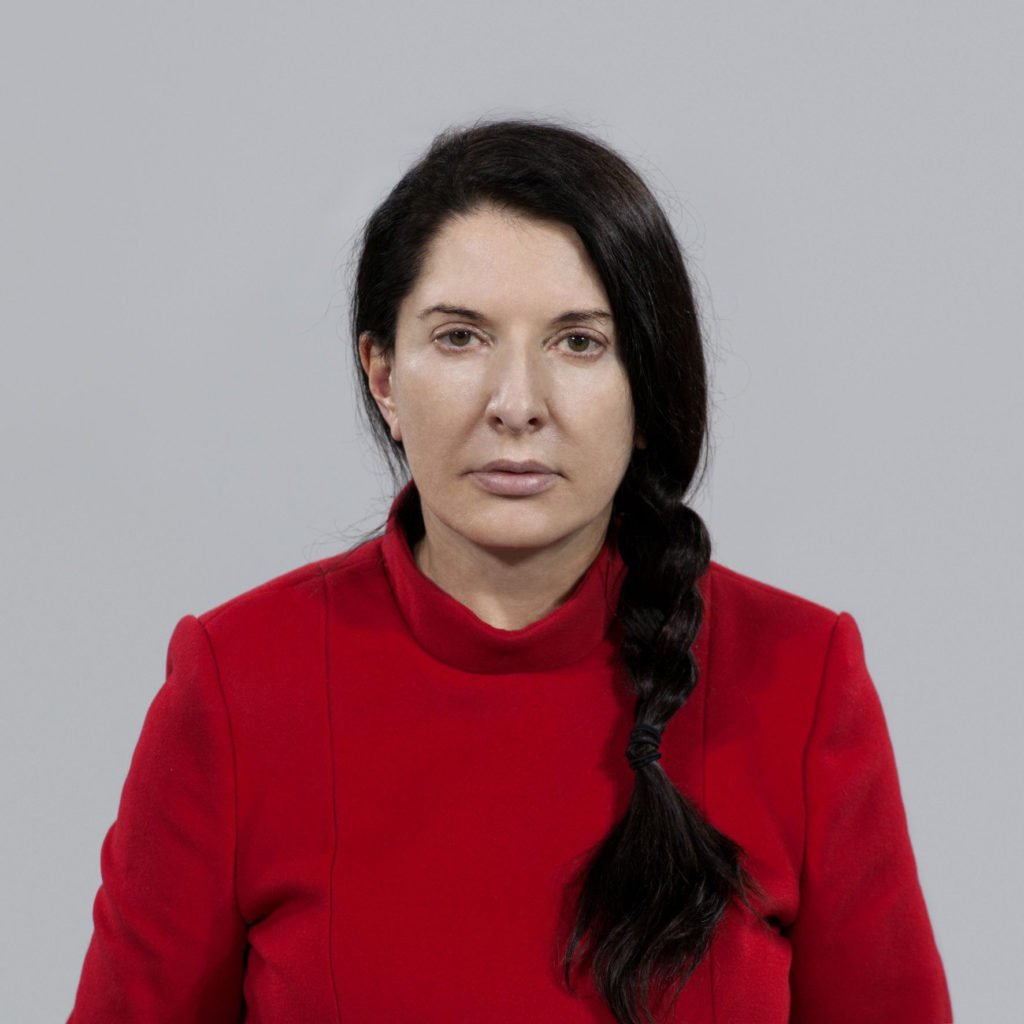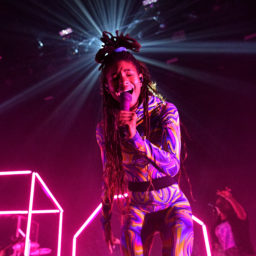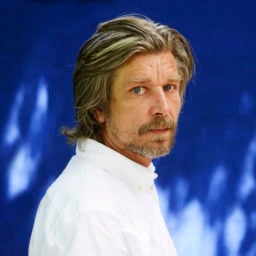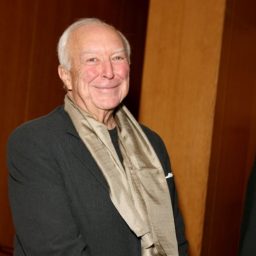In the atrium of MoMA, visitors were observing a woman in a long red dress sitting at a table. It was a blond wood table with blond wood chairs, as if it had come from IKEA. Opposite the woman in the red dress, a younger woman sat wearing a lightweight beige coat. The two women were gazing into each other’s eyes.
Levin noticed white tape on the floor marking out a square. People rimmed this square. Some were standing, others were sitting cross-legged, and all of them were watching the two women at its center.
Levin heard a small girl ask, “Mom, is that lady plastic?” “No, of course she’s not,” the mother replied in a hushed voice. “What is she, then?” the girl asked. “Mom? Mom?” The mother had no answer and her gaze did not leave the spectacle in front of her.
Levin could see the child’s point. The woman in the red dress was like plastic. Her skin looked as if the floodlights had bleached her to alabaster.
Suddenly, without any cue, the young woman got up and left the table. The woman in the long dress closed her eyes and bowed her head, but remained seated. After some moments a man sat down in the empty chair. The woman now raised her head and opened her eyes to look directly at him.
The man had a crumpled face with untidy gray hair and a short hooked nose. He looked small opposite the woman. The two of them gazed into each other’s eyes. More than gazing, Levin thought. Staring. The woman did not smile. She hardly even blinked. She was entirely still.
The man rearranged his feet and his hands twitched on his lap. But his head and eyes were very still as he looked back at the woman. He sat like that for maybe twenty minutes. Levin found himself absorbed by this spectacle, unwilling to leave. When the man finally left the chair, Levin watched him walk to the back of the atrium and lean his forehead against the wall. Levin wanted to go ask the man what had happened as he sat. How had it felt? But to do so, he realized, would be like asking a stranger what he prayed for.
By then another woman—middle-aged, broad-faced, tortoiseshell glasses—was sitting. Levin moved toward the black lettering on the wall that read: The Artist Is Present—Marina Abramović. The text beneath was obscured by the crowd entering and exiting the room.
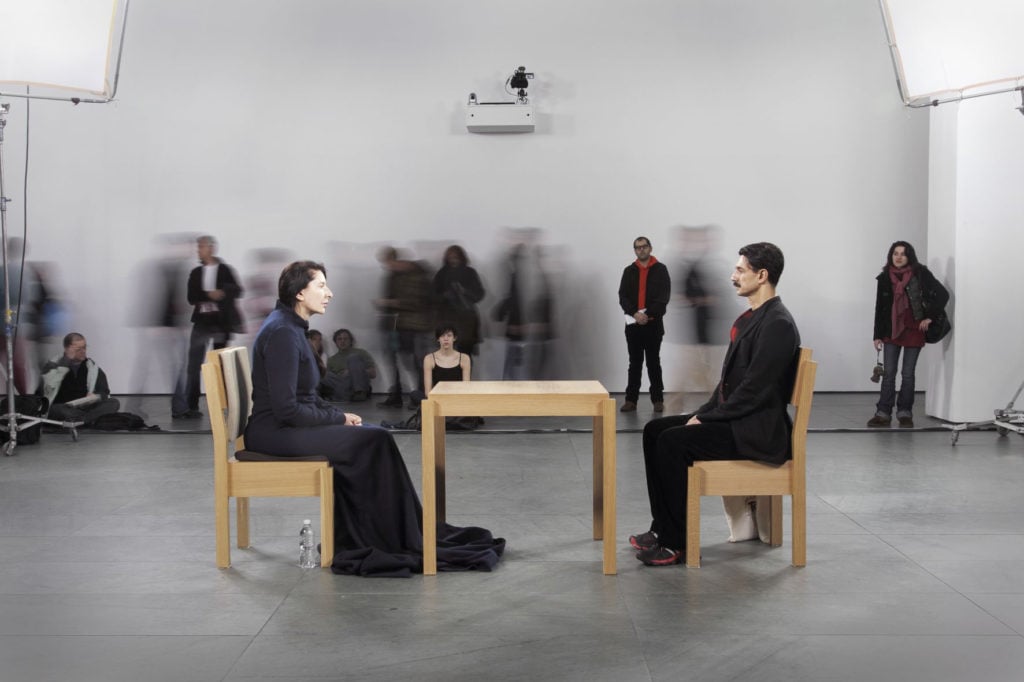
Marina Abramovic: The Artist Is Present. Photo by Marco Anelli. © 2010 Marco Anelli.
A professional photographer appeared to be documenting everyone who came and went from the table through a long lens mounted on a tripod. Levin nodded to him and the young man smiled briefly. He wore black pants and a black turtleneck, a three-day growth on his perfect jawline. When you lived in the Village you could be forgiven for thinking that cantilevered cheekbones and sculptured bodies were taking over the world.
The middle-aged woman sitting opposite the person Levin assumed was Marina Abramović had never been beautiful. She left after only a few minutes and the crowd took the opportunity to dissipate. Levin heard comments as people made their way to the stairs.
“Is that all that happens? Does she just sit?” “Don’t you want to see the Picassos?” “Do you think there’s any chance we’ll get a table? My feet are killing me.”
“Do you really want to try to get to M&M’s World today?” “Have you seen the Tim Burton? It’s so crowded.” “Is there a restroom on this floor?” “What time was she meant to be here?” Levin returned to the side of the square where he could see both people in profile once more. He sat down on the floor. A young man now sat opposite the woman. He was strikingly handsome with luminous eyes, a wide mouth, and shoulder- length curls, the face of an angel sent to visit dying children. Levin was interested to see if the woman would respond to this aesthetic but she didn’t, as far as he could see. She maintained the exact same gaze she’d been giving everyone else. She gazed gently and intently. Her body didn’t move. She sat very straight with her hands in her lap. From time to time her eyelids blinked but nothing else.
A hush descended on the atrium. It became evident that the young man was weeping. It wasn’t a dramatic gesture. Tears were running down his face while his glistening angel eyes continued to gaze at the woman. After some time, the woman began to weep in the same silent passive way. The weeping went on as if they could both see they must settle for losing something. Levin looked about and realized the atrium had quietly filled again and everyone was staring at the two people.
Levin thought there ought to be music. The woman in red was surrounded by the crowd and she was alone. It was utterly public but intensely private. A woman beside Levin pulled out her handkerchief, wiped her eyes, and blew her nose. Catching his glance, she smiled self-consciously. Along the row of faces watching the performance, Levin saw that many eyes were wet with tears.
Time went by and the man at the table was no longer weeping. He was leaning in toward the woman. Everything between the man and the woman became microscopic. Levin felt that something was lifting right out of the man and creeping away. He didn’t know if it was a good thing or a bad thing, but it was unfolding. The woman seemed to become enormous, as if she stretched out and touched the walls and stood as tall as all six floors of the atrium. Levin closed his eyes and breathed. His heart was racing. When he opened them again, she was once more a woman in a red dress, the right size, no longer young but full of virility and elegance. Something about her was as alluring as polished wood or light catching a sleeve of antique silk.
The afternoon passed. Levin didn’t want to leave. The man on the chair stayed too and the gaze between him and the woman never wavered. People moved in and out of the room, their mingled voices rising and falling. At 5:15 p.m. an announcement over the loudspeaker informed them the gallery would be closing in fifteen minutes. The suddenness of it made Levin jump. People leaned away from walls and looked about. Men and women rose from the floor, stretching out knees and hips and calves. Gathering their belongings, they smiled at one another, lifting their eyebrows in looks of mutual curiosity. Others shook their heads almost imperceptibly, as if they had quite forgotten where they were and how late was the hour. Soon there was just a smattering of onlookers keen for the last moment.
The man and the woman remained motionless in the center of the room, their gazes still locked. At 5:25 a MoMA official walked across the square and spoke quietly to the man. He bowed his head to the woman and stood up. Some people clapped.
“The gallery is closed,” another official said. “Please leave.” Levin stood and stretched. His knees ached and numbness became pain as he walked toward the stairs. The woman was alone at the table, her head bowed. Only the photographer remained. Levin looked for the man with the angel eyes in the emptying lobby, but he had disappeared.
Emerging onto West 53rd, he heard a woman remark to her female companion, “She must be dying for the restroom.”
“What day is this?” the friend asked. “Day twenty-three, I think,” the woman replied. “She’s got a long way to go.”
“I expect she has one of those tubes,” the companion offered. “You know, and a bag. I mean, who could wait all day?”
“You mean a catheter?” the first woman asked. They disappeared into the subway entrance. Levin headed east to Fifth. He walked hearing nothing but the hush of the gallery crowd and the silence between the man and the woman. It was an oboe, he thought. An oboe that played off against a viola.
Once home he wished that Lydia was there. He wanted to tell her about the woman in the red dress and the crowd and the walk home. But the apartment was silent. He sat at the Steinway and, working up and down the keyboard, he teased out the melody he had glimpsed. He played as the city grew black and neon suffused the sky.
I watched him. There is nothing more beautiful than watching an artist at work. They are as waterfalls shot with sunshine.
Night crowds ebbed and flowed across Washington Square below. Levin’s shoulders and hands grew weary. At last, in an act of utter tenderness, he let his hand drift across the black sheen of the piano before closing the lid over the keys.
In bed, he turned onto his right side, imagining that at any moment Lydia would slip in beside him and hold him, and dark- ness would wing them to sleep.
There I left him and went back to MoMA. I stood in the atrium and considered the two empty chairs and the simple table. Every hour of the day an artist falls to earth and we fall beside them. I fell a long time ago with Arky Levin. But I fell before that beside Marina Abramović.
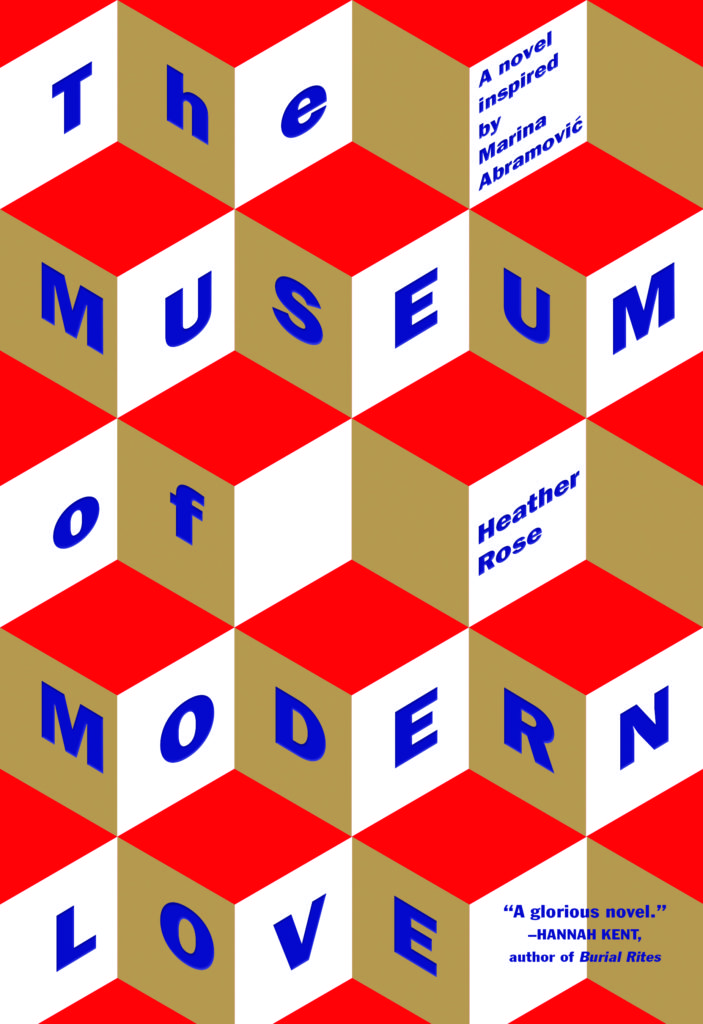
Cover of The Museum of Modern Love by Heather Rose. Courtesy of Algonquin.
From The Museum of Modern Love by Heather Rose © 2016 by Heather Rose. Reprinted by permission of Algonquin Books of Chapel Hill. All rights reserved.
